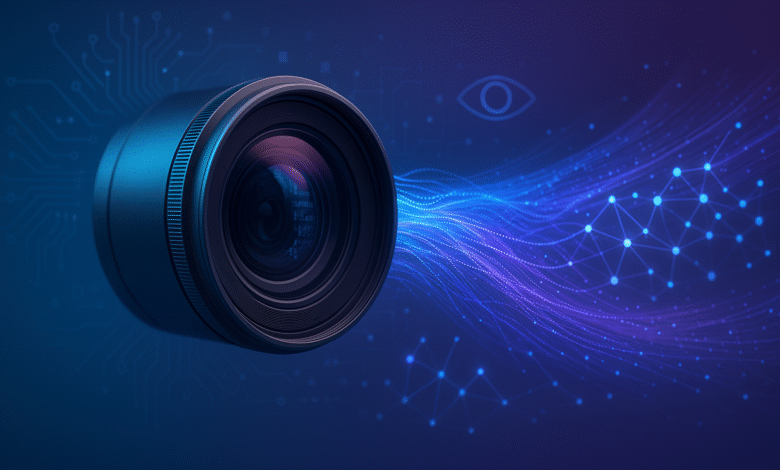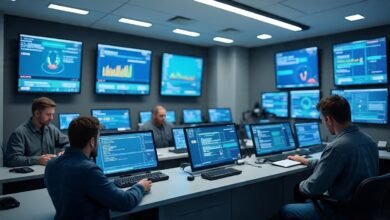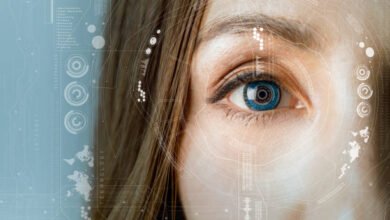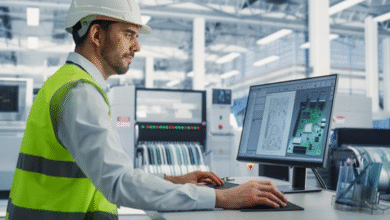
Vision AI represents one of the most transformative technologies in modern artificial intelligence. At its core, Vision AI (also known as computer vision) is a field of artificial intelligence that enables machines, robots, and software applications to interpret, understand, and analyze visual information from images and videos in ways that mimic human perception. Unlike traditional image processing methods that follow rigid rules, Vision AI uses advanced machine learning algorithms and deep learning models to recognize patterns, identify objects, detect anomalies, and make intelligent decisions based on visual data.
The importance of Vision AI has grown exponentially across industries because it solves real-world problems that were previously handled manually. From detecting manufacturing defects to identifying medical conditions, analyzing agricultural crops, and enabling autonomous vehicles, computer vision technology has become essential infrastructure for modern businesses. What makes Vision AI particularly powerful is its ability to process massive volumes of visual data in real time, making decisions faster and often more accurately than humans.
This technology isn’t new, but recent breakthroughs in deep learning, convolutional neural networks (CNNs), and access to large datasets have made it practical and affordable for businesses of all sizes. Whether you’re running a retail store, managing a manufacturing facility, or developing cutting-edge autonomous systems, understanding Vision AI gives you a competitive advantage. In this guide, we’ll explore how Vision AI works, its key applications across different industries, and how businesses can leverage this technology to drive efficiency, improve safety, and unlock new revenue opportunities.
How Vision AI Works: The Technology Behind the Scene
Computer vision operates through a systematic process that combines image capture, data processing, and machine learning inference. Understanding this workflow helps explain why Vision AI is so powerful and why implementation requires careful planning.
The process begins with image recognition, where cameras or sensors capture visual data from the environment. These images contain millions of pixels, each with specific color values and characteristics. The Vision AI system doesn’t initially understand what it’s seeing—it just sees raw numerical data. This is where deep learning comes in.
The second stage involves preprocessing and feature extraction. Raw images are often adjusted for lighting, contrast, and clarity to ensure the model can process them effectively. Advanced algorithms then identify important visual features—edges, shapes, textures, and patterns that help distinguish different objects. A convolutional neural network (CNN) is the primary architecture used for this task. CNNs are specifically designed to process visual data by applying multiple layers of filters that progressively extract higher-level features from the raw input.
Once features are extracted, the model performs image classification or object detection. Image classification answers “what is this?” by categorizing entire images into predefined categories. Object detection goes further—it identifies multiple objects within an image, determines their locations, and assigns labels to each. This is why autonomous vehicles use Vision AI: they need real-time object detection to identify pedestrians, other vehicles, traffic signs, and road hazards simultaneously.
Real-time image processing capabilities make Vision AI particularly valuable for dynamic applications. Manufacturing facilities use Vision AI systems to inspect products at high speed on assembly lines. Surveillance systems analyze video feeds continuously to detect security threats. Agricultural drones process aerial imagery instantly to identify crop health issues. All of this happens because modern hardware and optimized algorithms allow Vision AI systems to process thousands of images per minute.
The final component is decision-making and output generation. Once the model understands what it’s seeing, the Vision AI application takes action. It might flag a defective product, alert security personnel to suspicious activity, recommend a prescription adjustment based on medical imaging, or adjust steering in an autonomous vehicle. This complete pipeline—capture, process, analyze, and act—is what defines practical Vision AI implementation.
Key Applications of Vision AI Across Industries
Computer vision applications have revolutionized how businesses operate in nearly every sector. Here’s how leading organizations are deploying Vision AI technology:
Manufacturing and Quality Control
Manufacturing is where Vision AI delivers immediate, measurable ROI. Defect detection systems use high-resolution cameras and deep learning to inspect products at speeds humans cannot match. Instead of relying on tired inspectors who miss issues or incorrectly flag good products, Vision AI systems provide consistent, objective analysis.
These systems can detect:
- Surface defects and scratches invisible to the naked eye
- Incorrect labels or missing components
- Micro-cracks and material degradation
- Misalignments that affect product performance
- Color inconsistencies that violate quality standards
By implementing visual inspection technology, manufacturers reduce defects reaching customers, minimize warranty costs, and improve brand reputation. The systems learn and improve continuously—as they encounter new defect types, they’re retrained to catch those issues in the future.
Healthcare and Medical Imaging
Computer vision is transforming medical diagnosis and patient outcomes. Radiologists traditionally spent hours manually analyzing X-rays, MRIs, CT scans, and pathology images. Diagnostic errors occurred due to fatigue, individual bias, and the sheer volume of cases.
Vision AI systems now assist physicians by:
- Detecting tumors and abnormal growths in medical images
- Identifying early signs of diseases like diabetic retinopathy
- Analyzing blood cell morphology and identifying malignancies
- Measuring anatomical features for surgical planning
- Monitoring patient movement to detect neurological conditions
These applications don’t replace doctors—they augment their capabilities. A radiologist reviews a Vision AI flagged image knowing where to focus their attention. This collaboration improves diagnostic accuracy while reducing the time physicians spend on routine image analysis, allowing them to focus on complex cases requiring human judgment.
Autonomous Vehicles and Transportation
Self-driving cars are essentially Vision AI in motion. Multiple cameras around the vehicle feed continuous video streams to object detection models running in real time. These systems must simultaneously identify pedestrians, other vehicles, cyclists, traffic signs, road markings, and hazards—all while the vehicle is moving.
The computer vision technology powering autonomous vehicles performs:
- Pedestrian and cyclist detection to prevent collisions
- Traffic sign recognition for speed limit compliance
- Lane detection for staying on the road
- Obstacle detection to prevent accidents
- Traffic light recognition for intersection navigation
This high-stakes application shows both the power and current limitations of Vision AI. Autonomous vehicles operate safely in most conditions, but edge cases—unusual weather, unexpected obstacles, ambiguous situations—still challenge the technology.
Also Read: The Role of AI in Modern Visual Inspection
Retail and E-Commerce
Retailers use computer vision applications to enhance customer experience and improve operations. Image recognition technology powers:
- Visual product search, where customers find items by uploading photos
- Automated checkout systems that identify products as customers add them to carts
- Shelf analytics that detect empty shelves and out-of-stock items
- Planogram compliance checking to ensure products are displayed correctly
- Inventory management with real-time stock counting
These applications directly impact revenue. Customers who can search by image make more purchases. Automated checkout reduces friction. Proper product displays improve impulse buying. Computer vision technology in retail isn’t just about novelty—it drives genuine business value.
Agriculture and Crop Monitoring
Farmers increasingly use Vision AI through drone imagery and ground-based sensors. Computer vision applications help with:
- Crop health monitoring by analyzing plant color and growth patterns
- Weed detection and targeted herbicide application
- Pest identification and early intervention
- Yield prediction based on visual crop assessment
- Livestock health monitoring through behavioral analysis
This “precision agriculture” approach uses data to optimize every aspect of farming. Rather than apply pesticides uniformly across a field, farmers use visual inspection data to treat only affected areas. Rather than guess at harvest timing, they use visual assessment of crop maturity. The result is higher yields, lower costs, and more sustainable practices.
Security and Surveillance
Real-time image processing makes surveillance systems intelligent. Traditional CCTV just records; intelligent systems act. Vision AI applications in security include:
- Facial recognition for access control and identifying known threats
- Crowd detection and density monitoring
- Suspicious behavior detection (stopped vehicles, abandoned objects)
- Weapon detection in crowded areas
- Heat mapping to understand foot traffic patterns
Advanced Vision AI systems learn what “normal” looks like in a specific location, then alert security when anomalies occur. This reduces false alarms while catching actual threats.
The Technology Enabling Vision AI
Several technological advances made modern Vision AI possible:
Deep Learning and Neural Networks: Convolutional neural networks (CNNs) proved particularly effective for image recognition tasks. These networks are inspired by how the human visual cortex processes information—through multiple layers of increasing complexity.
Large Datasets: Models need millions of labeled images to learn effectively. The availability of datasets like ImageNet, COCO, and specialized domain-specific collections enabled training powerful models.
GPU Computing: Processing billions of calculations required for deep learning at practical speeds demands specialized hardware. Graphics processing units (GPUs) made this feasible and affordable.
Edge AI: Not all Vision AI processing happens in the cloud. Edge AI brings computation closer to the camera, enabling real-time processing without network latency. This is critical for autonomous vehicles, robotics, and safety-critical applications.
Transfer Learning: Rather than train models from scratch, developers use pre-trained models and adapt them for specific tasks. This dramatically reduces training time and data requirements, democratizing Vision AI technology**.
Challenges and Limitations of Vision AI
Despite impressive capabilities, Vision AI faces real limitations:
Data Quality and Bias: Models reflect their training data. If training data lacks diversity or contains biases, the Vision AI system perpetuates those biases. Facial recognition systems trained primarily on lighter-skinned individuals perform worse on darker skin tones—a well-documented problem in the industry.
Adversarial Examples: Carefully crafted image manipulations that fool Vision AI systems without appearing unusual to humans exist. This raises security concerns for critical applications.
Edge Cases: Vision AI struggles with unusual scenarios outside its training distribution. Rare weather conditions, unexpected object arrangements, or novel situations can confuse even sophisticated systems.
Privacy Concerns: Facial recognition and object detection systems raise surveillance and privacy questions that society is still grappling with. Regulatory frameworks like GDPR affect how computer vision applications can be deployed.
Computational Cost: Powerful Vision AI models require significant computing resources. Organizations must balance model accuracy against deployment cost and speed.
The Future of Vision AI
Computer vision technology continues advancing rapidly. Emerging trends include:
Multimodal AI: Combining Vision AI with natural language processing creates systems that can understand and reason about visual content in context. A system can not only identify objects but explain what’s happening and why.
Autonomous Agents: Instead of just analyzing images, Vision AI systems increasingly take autonomous action. Robots see a task, plan an approach, and execute it without human intervention.
3D Vision: Beyond 2D images, Vision AI increasingly processes 3D data, enabling better understanding of spatial relationships and enabling applications like augmented reality.
On-Device Processing: As models become more efficient, sophisticated Vision AI runs directly on phones, cameras, and edge devices—enabling privacy-preserving applications without cloud connectivity.
Synthetic Data: Generating training data through simulation allows companies to create unlimited labeled datasets, overcoming one of Vision AI’s biggest limitations.
Getting Started with Vision AI
If you’re interested in implementing Vision AI for your organization, start with these steps:
Define your problem clearly. What specific task do you want Vision AI to automate? The more specific, the better your results.
Evaluate existing solutions. Google Cloud’s Vision AI provides pre-built models for common use cases, while Plainsight offers enterprise computer vision platforms for custom implementations.
Determine data requirements. How many images do you need? How will you label them? What quality standards apply?
Start with pilots. Rather than company-wide rollout, implement Vision AI in a controlled environment, measure results, and iterate.
Plan for monitoring. Vision AI systems can degrade over time as conditions change. Plan for continuous monitoring and retraining.
Conclusion
Vision AI represents a fundamental shift in how machines understand the world. Computer vision technology has moved from academic research to practical business infrastructure, delivering measurable value across manufacturing, healthcare, transportation, retail, agriculture, and security. While challenges remain—particularly around bias, privacy, and edge cases—the trajectory is clear: Vision AI will become increasingly central to business operations. Organizations that understand Vision AI capabilities and limitations today position themselves to lead in industries where automated visual understanding becomes essential. Whether you’re building autonomous systems, improving quality control, enhancing security, or creating better customer experiences, Vision AI technology provides powerful tools to achieve those goals more efficiently and effectively than traditional approaches.











